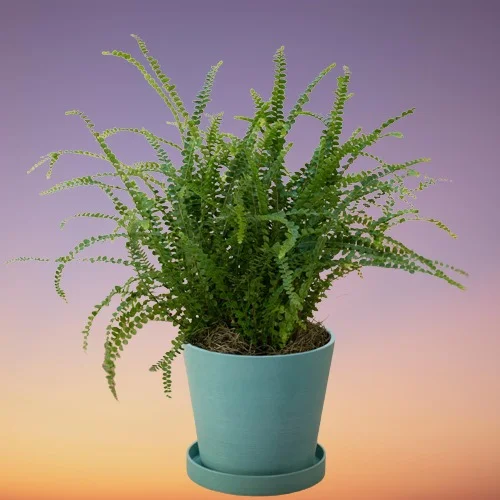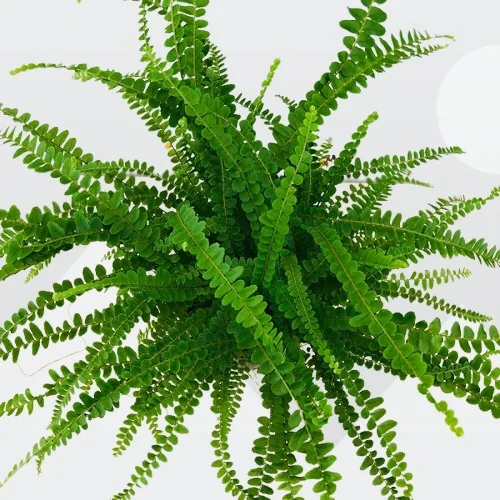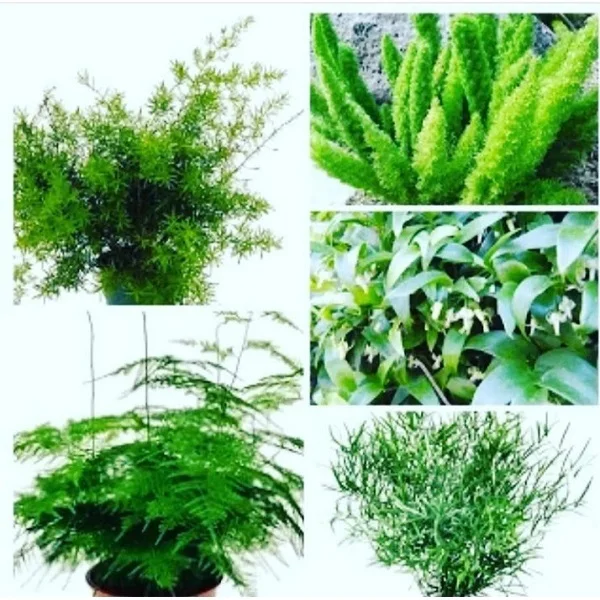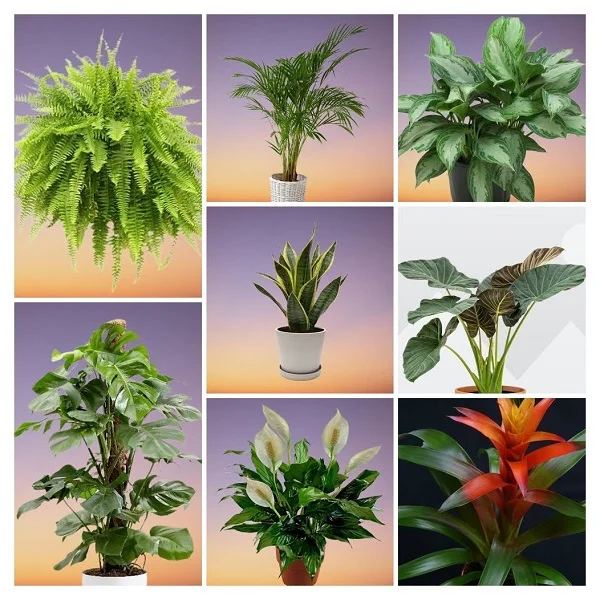Lemon Button Fern (Nephrolepis cordifolia 'Duffii') Indoor Care, Propagation, Problems and Solutions
Some links in this post may be affiliate links
Lemon Button Fern (Nephrolepis cordifolia 'Duffii') thrives in bright indirect light, warm and humid conditions and consistently moist, rich, well-drained soil coupled with fortnightly feeding in the growing season.
Lemon Button Fern is easy to grow but if the conditions are not right, it may develop some problems like brown leaves, yellow leaves, brown tips, leaf drop, crispy leaves among others. In this guide we will cover everything you need to know to keep your fern thriving. First, we look at some facts about this fern.
Nephrolepis cordifolia 'Duffii' also called Button Sword Fern, Fishbone Fern or Little-leaved Sword Fern is among the popular fern plants with gracefully, drooping stems and small, round, button-like leaves which release a lemony aroma when crushed, hence the common name 'Lemon Button Fern'.
Button Sword Fern is a compact, small-sized, hardy fern which spreads by means of underground rhizomes; clumps of wiry stems that grow beneath the soil surface.

Botanical name: Nephrolepis cordifolia 'Duffii'
Family: Nephrolepidaceae
Common names: Lemon Button Fern, Button Sword Fern, Fishbone Fern, Little-leaved Sword Fern
Origin
Nephrolepis cordifolia 'Duffii' is native to the Pantropical regions of the world where it grows in swampy, damp, forest-like conditions.
How big do Lemon Button Ferns get?
Lemon Button Fern is a compact fern which grows to a height of about 1 foot and 1 foot wide. It is a dwarf variety of the Boston Fern (Nephrolepis exaltata 'Bostoniensis'). On account of its compact size, Lemon Button Fern is among the best low-light small plants for the limited spaces.
Is Lemon Button Fern poisonous?
No. Lemon Button Fern is non-toxic to humans and pets as indicated by ASPCA. Lemon Button Fern is safe for cats, dogs and other pets in the home.
Where to Buy
Are you looking to add Lemon Button Ferns to your plant collection, you may obtain them online from Amazon (Link to Amazon).
How to care for Lemon Button Fern indoors
To care for Lemon Button Fern indoors, provide bright indirect light, average warmth of 15-250C, humidity of 70-80% and consistently moist, fertile, well-drained soil coupled with fortnightly feeding during the growing season.
Nephrolepis cordifolia 'Duffii' care requires repotting every 2-3 years to provide adequate space for the growth of the rhizome. Regular pruning is necessary to keep it neat and tidy. Keep reading for a detailed account on these growing conditions and how to provide them.

Light Requirements
How much sun does Lemon Button Fern need?
Lemon Button Fern grows best in bright indirect light (dappled light). Keep it away from direct sunlight as it may scorch the fronds.
If the light is too little it may lead to yellowing, leaf drop and leggy growth. Therefore, where the natural lighting is insufficient, use a full spectrum grow light to supplement it.
Turn the pot regularly to ensure that the plant receives adequate light on all sides for even growth and prevent legginess.
Watering
How often should I water Lemon Button Fern?
Do not water your Lemon Button Fern on a schedule to avoid either overwatering or underwatering both of which are detrimental to the growth of the plant.
Water your Lemon Button Fern thoroughly in spring and summer while allowing the top 1-2 inches of soil to dry out between waterings. Keep the soil evenly moist but not soggy to avoid rotting, yellowing and leaf drop.
Cut down on watering in fall and winter as growth is minimal at this time to keep the soil slightly moist. Never allow the soil to dry out completely to prevent wilting, drooping, yellowing and leaf loss.
Use chlorine-free water like rain water to prevent browning of leaf tips and edges. The water should be at room temperature to avoid cold shock which can result in stunted growth, leaf fall and death of the plant.
Ensure the pot has a drainage hole and the soil is well-draining to prevent the soil from getting soggy as it can lead to rotting and death of the plant.
Temperature & Humidity
Lemon Button Fern flourishes in an average warmth of 15-250C. Keep it away from sources of drafts like AC units, stoves, hot air vents, windy doors, drafty windows to prevent temperature flactuactions as they can cause reduced growth and leaf drop.
Button Sword Fern prefers a humidity of 70-80%; too low humidity will lead to brown leaf tips and edges. To increase humidity, set the pot on a wet pebble tray, use a cool mist humidifier or group the plants together.
You may also grow the fern in a well-lit bathroom, kitchen, laundry area and other humid areas. Do not mist the fern to minimize fungal diseases. Maintain good air circulation to discourage fungal infestations.
Due to its affinity for warm, humid conditions, Lemon Button Fern is one of the best plants for a closed terrarium where a high humidity can be maintained.
Fertilizer
What is the best fertilizer for Lemon Button Fern?
Feed your Lemon Button Fern with a liquid, water-soluble fertilizer every 2-3 weeks in spring and summer to promote a lush growth.
Withhold feeding in fall and winter as growth is reduced at this time; feeding at this time may result in fertilizer burn which presents as browning of leaf edges and tips.
Occasionally, leach out accumulated salts by wetting the soil throughly until the water drains through the drainage hole. Repeat the process several times to get rid of all the salts.
Potting Soil
What kind of soil do Lemon Button Ferns like?
Lemon Button Ferns like a loose, airy, well-draining soil that is rich in organic matter to prevent it from getting soggy while providing the required nutrients. A blend of 2 parts allpurpose potting mix and 1 part perlite is ideal for this plant.
Repotting
Repot your Lemon Button Fern every 2-3 years at the beginning of the growing season (spring to early summer) to provide adequate room for the growth of the rhizome.
One sign of an overcrowded (pot-bound) fern is wilting leaves. Failure to repot an overcrowded fern can result in death of the plant.
Select a pot that is 1 size larger that has drainage hole to prevent the soil from getting soggy to prevent rotting and eventual death of the plant. Take a look at these ceramic pots with a saucer on Amazon.
You can also be divide a large Button Sword Fern into several sections and pot the sections individually to propagate new ferns.
Pruning
How do you prune a Lemon Button Fern?
Pruning Lemon Button Fern involves:
- Removal of dead and damaged fronds as they occur to keep the fern neat as well as discourage pests and diseases.
- Cutting back the older fronds which turn brown; cut them off at the base to maintain it neat as well as improve air circulation. use a sharp, sterilized pruning scissors to minimize injuries and prevent cross-contamination.
Lemon Button Fern Propagation
Lemon Button Fern (Nephrolepis cordifolia 'Duffii') propagation is done by division at the beginning of the growing season. It can also be propagated from spores but they are difficult to grow.
Propagating Lemon Button Fern by plant division
- One day before, thoroughly water the fern to make it easier to divide as well as hasten establishment.
- Carefully, remove the fern from its pot and divide the rhizome into several sections. Ensure each section has adequate roots.
- Fill small pots a thirdway with a well-draining soil and moisten it slightly.
- Place the section in the center of the pot and continue to fill the pot while taking care not bury the rhizomes too deep; maintain them at the same soil level that they were in the previous pot.
- Place the pots in a warm, well-lit place away from direct sunlight to avoid scorching.
- Maintain the soil moist through out until the new ferns are well established after which you can begin routine care.

Lemon Button Fern Problems & Remedies
Lemon Button Fern (Nephrolepis cordifolia 'Duffii') problems are yellowing, browning, leaf drop, brown leaf tips, lack of growth, pests and diseases among others. Keep reading for more on these problems and how to fix them.
Yellowing leaves
Why is my Lemon Button Fern turning yellow?
Your Lemon Button Fern is turning yellow due to inconsistent watering, soggy soil, too little light, temperature stress or nutrients deficiency.
How to fix it
Inconsistent watering: Do not water on a schedule; water when the top 1-2 inches of soil feel dry but do not allow the soil to dry out completely.
Soggy soil: Use a pot with a drainage hole and loose, free-draining soil.
Too little light: Position the plant infront a well-lit window where it will receive bright light away from direct sunlight.
Temperature stress: Keep the fern away from drafts coming from AC units, windy doors and windows, stoves, hot air vents and others.
Nutrients deficiency: Fertilize the fern with a balanced, water-soluble fertilizer every 2-3 weeks in spring and summer.
Browning leaves
Why is my Lemon Button Fern turning brown?
Your Lemon Button Fern is turning brown due to inconsistent watering, soggy soil, drafts, direct sunlight or salts buildup.
How to fix it
Inconsistent watering: Water when the top 1-2 inches of soil dry out but do not allow the soil to dry out completely. Do not water on a schedule.
Soggy soil: Use a pot that has a drainage hole and well-draining soil.
Drafts: Keep the fern away from sources of drafts like heat sources, AC units, windy doors, drafty windows among others.
Direct sunlight: Move the fern to a more shaded away from direct sunshine.
Salts buildup: Regularly flush out accumualted salts by running a stream of water through the soil until it comes out through the drainage hole. Let it run for about 5-10 minutes.
Leaf drop
Why are the leaves falling off my Lemon Button Fern?
The leaves are falling off your Lemon Button Fern due to inconsistent watering, soggy soil, drafts, use of cold water, direct sunlight or being pot-bound.
How to fix it
Inconsistent watering: Water when the top 1-2 inches of soil dry out and never allow the soil to dry out completely.
Soggy soil: Use a pot that has a drainage hole and well-draining soil.
Drafts: Keep the plant away from sources of drafts like heat sources, AC units, windy doors, drafty windows among others.
Use of cold water: Use water that is at room temperature to prevent cold shock.
Direct sunlight: Keep the fern away from direct sunshine.
Being pot-bound: Repot the plant into a pot one size larger in well-draining soil.
Brown leaf tips
Why are the tips on my Lemon Button Fern turning brown?
The tips on your Lemon Button Fern are turning brown due to dry air, underwatering, use of hard water or fertilizer burn.
How to fix it
Dry air: Set the pot on a wet pebble tray, use a humidifier or group the plants together to raise humidity.
Underwatering: Water when the top 1-2 inches of soil dry out but do not allow the soil to dry out completely.
Use of hard water: Use water that is chlorine-free like rain water or filtered water.
Fertilizer burn: Do not feed in fall and winter as growth is minimal. Every 1-2 months, leach out accumulated salts from the soil.
Lack of growth
Why is my Lemon Button Fern not growing?
Your Lemon Button Fern is not growing due to inconsistent watering, soggy soil, too little light, extreme temperatures, use of cold water, pests infestations or lack of nutrients.
How to fix it
Inconsistent watering: Do not water on a schedule; water when the top 1-2 inches of soil dry; do not allow the soil to dry out completely.
Soggy soil: Use a pot with a drainage hole and loose, well-draining soil.
Too little light: Position the plant in a brighter spot where it will receive bright indirect light.
Extreme emperatures: Keep the fern away from drafts emanating from AC units, windy doors, drafts windows, stoves, hot air vents among others.
Use of cold water: Use water that is at room temperature to prevent cold shock.
Pests infestations: Regularly inspect the fern for pests and carry out timely control measures.
Lack of nutrients: Feed the fern with a balanced, water-soluble fertilizer every 2-3 weeks in spring and summer.
Pests
Common pests on Lemon Button Fern are scale insects and mealybugs.
How to fix it
- Isolate the affected plant to prevent spread to other plants.
- Treat the infested fern with insecticidal soap or neem oil as per the manufacturers' recommendations.
- Regularly, check between and underneath the leaves for these pests and carry out timely control measures.
- Maintain the plant well pruned to depress the pest infestations.
Diseases
Lemon Button Fern is prone to the following two diseases:
1. Leaf spot disease which is prevalent in damp, stuffy conditions. It presents as brown, soft leaf spots.
How to fix it
- Isolate the affected plant to minimize cross-infection.
- Treat the affected plant with horticultural oil as per the manufacturer's instructions.
- Avoid wetting the leaves during watering to discourage the disease infestation; water from the bottom instead.
- Improve the air flow for the plant to discourage the disease.
2. Root-rot disease which is enhanced by soggy soil. It is characterized by wilting, yellowing, browning and eventual collapse of the plant.
How to fix it
- Gently, slip the plant out of its pot and inspect the roots; brown-black mushy roots indicate root-rot.
- Cut away the rotten roots and treat the healthy roots with a copper-based fungicidal solution as indicated by the manufacturer.
- Repot the plant in fresh, well-draining soil in a pot with a drainage hole.
- Withhold watering for a few days to give the plant enough time to loss the excess water. After the dry period, resume routine care.
You liked it? Share on social media.
Related Content
Amazon Associates Disclosure
Homeplantsguide.com is a participant in the Amazon Services LLC Associates Program, an affiliate advertising program designed to provide a means for sites to earn advertising fees by advertising and linking to amazon.com.





